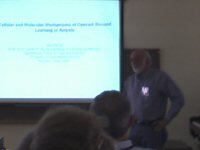Main Menu
Welcome

A central neuron in the buccal feeding CPG is the "decision-making neuron" B51. It fires a plateau potential late in the feeding cycle and only during ingestive behaviors. Depolarizing B51 increases ingestive programs and hyperpolarizing it reduces ingestion.
Operant conditioning is done by stimulating the esophageal nerve with electrical activity mimicking food delivery. Every time the animal bites, the nerve is stimulated. This leads to long term memory after only a few minutes of training. Studying B51 after training revealed an increased input resistance and decreased burst threshold in contingently reinforced animals compared to control animals. These results conform to results from B51 after in vitro conditioning of isolated buccal ganglia. Even experimentally induced changes in B51 alone lead to an increase in ingestive motor patterns. The B51 changes can also be observed if the neuron is taken in isolated cell culture and trained by depolarization and contingent dopamine application, indicating that the transmitter mediating reward is dopamine.
What happens inside of B51 to produce these significant changes? It turned out that cAMP is involved as well as PKC. It appears that the main intracellular convergence site of operant behavior and reward is an adenylate cyclase.

Posted on Saturday 09 June 2007 - 01:27:44 comment: 0
{TAGS}
{TAGS}
You must be logged in to make comments on this site - please log in, or if you are not registered click here to signup
Render time: 0.0588 sec, 0.0052 of that for queries.





